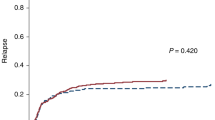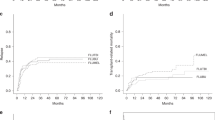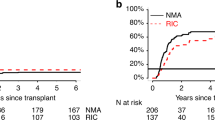Abstract
Numerous reduced-intensity conditioning regimens for allogeneic hematopoietic cell transplantation are currently being explored, primarily in older patients and in individuals with comorbid conditions who are not eligible for conventional myeloablative conditioning regimens. There is agreement that these approaches have reduced early transplant-related (non-relapse) toxicity and mortality. It is unclear, however, whether these strategies improve long-term survival. Furthermore, as most trials with reduced-intensity regimens have enrolled older patients and patients with comorbid conditions, it is not appropriate to compare the results of these trials to those obtained with more conventional approaches. It remains to be determined whether younger patients, and patients without comorbid conditions, will derive significant long-term benefits from reduced-intensity regimens when compared to conventional strategies. It may be that the different approaches are complementary and in the end will preferentially serve specific patient populations based on age, comorbid conditions and malignancy type. To determine the role of reduced-intensity approaches, controlled prospective trials are needed, with enrolled patients being stratified according to comorbid conditions, disease characteristics, pre-transplant therapy and source of stem cells, at a minimum.
This is a preview of subscription content, access via your institution
Access options
Subscribe to this journal
Receive 12 print issues and online access
$259.00 per year
only $21.58 per issue
Buy this article
- Purchase on Springer Link
- Instant access to full article PDF
Prices may be subject to local taxes which are calculated during checkout


Similar content being viewed by others
References
Maris MB, Sandmaier BM, Storer BE, Chauncey T, Stuart MJ, Maziarz RT et al. Allogeneic hematopoietic cell transplantation after fludarabine and 2 Gy total body irradiation for relapsed and refractory mantle cell lymphoma. Blood 2004; 104: 3535–3542.
Slavin S, Nagler A, Naparstek E, Kapelushnik Y, Aker M, Cividalli G et al. Nonmyeloablative stem cell transplantation and cell therapy as an alternative to conventional bone marrow transplantation with lethal cytoreduction for the treatment of malignant and nonmalignant hematologic diseases. Blood 1998; 91: 756–763.
Giralt S, Thall PF, Khouri I, Wang X, Braunschweig I, Ippolitti C et al. Melphalan and purine analog-containing preparative regimens: reduced-intensity conditioning for patients with hematologic malignancies undergoing allogeneic progenitor cell transplantation. Blood 2001; 97: 631–637.
Niederwieser D, Maris M, Shizuru JA, Petersdorf E, Hegenbart U, Sandmaier BM et al. Low-dose total body irradiation (TBI) and fludarabine followed by hematopoietic cell transplantation (HCT) from HLA-matched or mismatched unrelated donors and postgrafting immunosuppression with cyclosporine and mycophenolate mofetil (MMF) can induce durable complete chimerism and sustained remissions in patients with hematological diseases. Blood 2003; 101: 1620–1629.
Aoudjhane M, Labopin M, Gorin NC, Shimoni A, Ruutu T, Kolb H-J et al. Comparative outcome of reduced intensity and myeloablative conditioning regimen in HLA identical sibling allogeneic haematopoietic stem cell transplantation for patients older than 50 years of age with acute myeloblastic leukaemia: a retrospective survey from the Acute Leukemia Working Party (ALWP) of the European group for Blood and Marrow Transplantation (EBMT). Leukemia 2005; 19: 2304–2312.
Weisser M, Schleuning M, Ledderose G, Rolf B, Schnittger S, Schoch C et al. Reduced-intensity conditioning using TBI (8 Gy), fludarabine, cyclophosphamide and ATG in elderly CML patients provides excellent results especially when performed in the early course of the disease. Bone Marrow Transplant 2004; 34: 1083–1088.
Anderson JE, Appelbaum FR, Schoch G, Gooley T, Anasetti C, Bensinger WI et al. Allogeneic marrow transplantation for myelodysplastic syndrome with advanced disease morphology: a phase II study of busulfan, cyclophosphamide, and total-body irradiation and analysis of prognostic factors (JCO 1996 14: 220–226) [author update]. Classic Papers Curr Comments 2002; 7: 237–244.
Barnes DWH, Corp MJ, Loutit JF, Neal FE . Treatment of murine leukaemia with x-rays and homologous bone marrow. Preliminary communication. BMJ 1956; 2: 626–627.
Weiden PL, Sullivan KM, Flournoy N, Storb R, Thomas ED, the Seattle Marrow Transplant Team. Antileukemic effect of chronic graft-versus-host disease. Contribution to improved survival after allogeneic marrow transplantation. N Engl J Med 1981; 304: 1529–1533.
Slavin S, Naparstek E, Nagler A, Ackerstein A, Kapelushnik J, Or R . Allogeneic cell therapy for relapsed leukemia after bone marrow transplantation with donor peripheral blood lymphocytes. Exp Hematol 1995; 23: 1553–1562.
Kolb HJ, Mittermüller J, Clemm Ch, Holler G, Ledderose G, Brehm G et al. Donor leukocyte transfusions for treatment of recurrent chronic myelogenous leukemia in marrow transplant patients. Blood 1990; 76: 2462–2465.
Sandmaier BM, McSweeney P, Yu C, Storb R . Nonmyeloablative transplants: preclinical and clinical results. Semin Oncol 2000; 27 (Suppl 5): 78–81.
Storb R, Yu C, McSweeney P . Mixed chimerism after transplantation of allogeneic hematopoietic cells. In: Thomas ED, Blume KG, Forman SJ (eds.) Hematopoietic Cell Transplantation, 2nd edn. Blackwell Science: Boston, 1999, pp 287–295.
Strober S, Modry DL, Hoppe RT, Pennock JL, Bieber CP, Holm BI et al. Induction of specific unresponsiveness to heart allografts in mongrel dogs treated with total lymphoid irradiation and antithymocyte globulin. J Immunol 1984; 132: 1013–1018.
Lowsky R, Takahashi T, Liu YP, Dejbakhsh-Jones S, Grumet FC, Shizuru JA et al. Protective conditioning for acute graft-versus-host disease. N Engl J Med 2005; 353: 1321–1331.
de Lima M, Anagnostopoulos A, Munsell M, Shahjahan M, Ueno N, Ippoliti C et al. Nonablative versus reduced-intensity conditioning regimens in the treatment of acute myeloid leukemia and high-risk myelodysplastic syndrome: dose is relevant for long-term disease control after allogeneic hematopoietic stem cell transplantation. Blood 2004; 104: 865–872.
Maris MB, Sandmaier BM, Storer BE, Maloney DG, Shizuru JA, Agura E et al. Unrelated donor granulocyte colony-stimulating factor-mobilized peripheral blood mononuclear cell transplantation after nonmyeloablative conditioning: the effect of postgrafting mycophenolate mofetil dosing. Biol Blood Marrow Transplant 2006; 12: 454–465.
Hegenbart U, Niederwieser D, Sandmaier BM, Maris MB, Shizuru JA, Greinix H et al. Treatment for acute myelogenous leukemia by low-dose, total-body, irradiation-based conditioning and hematopoietic cell transplantation from related and unrelated donors. J Clin Oncol 2006; 24: 444–453.
Sorror ML, Maris MB, Sandmaier BM, Storer BE, Stuart MJ, Hegenbart U et al. Hematopoietic cell transplantation after nonmyeloablative conditioning for advanced chronic lymphocytic leukemia. J Clin Oncol 2005; 23: 3819–3829.
Giralt S, Estey E, Albitar M, van Besien K, Rondón G, Anderlini P et al. Engraftment of allogeneic hematopoietic progenitor cells with purine analog-containing chemotherapy: harnessing graft-versus-leukemia without myeloablative therapy. Blood 1997; 89: 4531–4536.
Morris ES, MacDonald KP, Hill GR . Stem cell mobilization with G-CSF analogs: a rational approach to separate GVHD and GVL? Blood 2006; 107: 3430–3435.
Sutton L, Chastang C, Ribaud P, Jouet JP, Kuentz M, Attal M et al. Factors influencing outcome in de novo myelodysplastic syndromes treated by allogeneic bone marrow transplantation: a long-term study of 71 patients Societe Francaise de Greffe de Moelle. Blood 1996; 88: 358–365.
Zikos P, Van Lint MT, Frassoni F, Lamparelli T, Gualandi F, Occhini D et al. Low transplant mortality in allogeneic bone marrow transplantation for acute myeloid leukemia: a randomized study of low-dose cyclosporin versus low-dose cyclosporin and low-dose methotrexate. Blood 1998; 91: 3503–3508.
Scott BL, Sandmaier BM, Storer B, Maris MB, Sorror ML, Maloney DG et al. Myeloablative vs nonmyeloablative allogeneic transplantation for patients with myelodysplastic syndrome or acute myelogenous leukemia with multilineage dysplasia: a retrospective analysis. Leukemia 2006; 20: 128–135.
Ho AYL, Pagliuca A, Kenyon M, Parker JE, Mijovic A, Devereux S et al. Reduced-intensity allogeneic hematopoietic stem cell transplantation for myelodysplastic syndrome and acute myeloid leukemia with multilineage dysplasia using fludarabine, busulphan and alemtuzumab (FBC) conditioning. Blood 2004; 104: 1616–1623.
Shlomchik WD, Couzens MS, Tang CB, McNiff J, Robert ME, Liu J et al. Prevention of graft versus host disease by inactivation of host antigen-presenting cells. Science 1999; 285: 412–415.
Deeg HJ, Amylon MD, Harris RE, Collins R, Beatty PG, Feig S et al. Marrow transplants from unrelated donors for patients with aplastic anemia: minimum effective dose of total body irradiation. Biol Blood Marrow Transplant 2001; 7: 208–215.
Kojima S, Inaba J, Yoshimi A, Takahashi Y, Watanabe N, Kudo K et al. Unrelated donor marrow transplantation in children with severe aplastic anaemia using cyclophosphamide, anti-thymocyte globulin and total body irradiation. Br J Haematol 2001; 114: 706–711.
Bacigalupo A, Locatelli F, Lanino E, Marsh J, Soci G, Maury S et al. Fludarabine, cyclophosphamide and anti-thymocyte globulin for alternative donor transplants in acquired severe aplastic anemia: a report from the EBMT-SAA Working Party. Bone Marrow Transplant 2005; 36: 947–950.
Zeiser R, Spyridonidis A, Wasch R, Ihorst G, Grullich C, Bertz H et al. Evaluation of immunomodulatory treatment based on conventional and lineage-specific chimerism analysis in patients with myeloid malignancies after myeloablative allogeneic hematopoietic cell transplantation. Leukemia 2005; 19: 814–821.
Kolb HJ, Schmidt C, Barrett AJ, Schendel DJ . Graft-versus-leukemia reactions in allogeneic chimeras. Blood 2004; 103: 767–776.
Scott BL, Storer B, Loken M, Storb R, Appelbaum FR, Deeg HJ . Pretransplantation induction chemotherapy and posttransplantation relapse in patients with advanced myelodysplastic syndrome. Biol Blood Marrow Transplant 2005; 11: 65–73.
Maris MB, Niederwieser D, Sandmaier BM, Storer B, Stuart M, Maloney D et al. HLA-matched unrelated donor hematopoietic cell transplantation after nonmyeloablative conditioning for patients with hematologic malignancies. Blood 2003; 102: 2021–2030.
Guardiola P, Runde V, Bacigalupo A, Ruutu T, Locatelli F, Boogaerts MA et al. Retrospective comparison of bone marrow and granulocyte colony-stimulating factor-mobilized peripheral blood progenitor cells for allogeneic stem cell transplantation using HLA identical sibling donors in myelodysplastic syndromes. Blood 2002; 99: 4370–4378.
Schmitz N, Bacigalupo A, Hasenclever D, Nagler A, Gluckman E, Clark P et al. Allogeneic bone marrow transplantation vs filgrastim-mobilised peripheral blood progenitor cell transplantation in patients with early leukaemia: first results of a randomised multicentre trial of the European Group for Blood and Marrow Transplantation. Bone Marrow Transplant 1998; 21: 995–1003.
Bensinger WI, Martin PJ, Storer B, Clift R, Forman SJ, Negrin R et al. Transplantation of bone marrow as compared with peripheral-blood cells from HLA-identical relatives in patients with hematologic cancers. N Engl J Med 2001; 344: 175–181.
Liu J, Anderson BE, Robert ME, McNiff JM, Emerson SG, Shlomchik WD et al. Selective T-cell subset ablation demonstrates a role for T1 and T2 cells in ongoing acute graft-versus-host disease: a model system for the reversal of disease. Blood 2001; 98: 3367–3375.
Anderson BE, McNiff JM, Matte C, Athanasiadis I, Shlomchik WD, Shlomchik MJ . Recipient CD4+ T cells that survive irradiation regulate chronic graft-versus-host disease. Blood 2004; 104: 1565–1573.
Clift RA, Buckner CD, Appelbaum FR, Bearman SI, Petersen FB, Fisher LD et al. Allogeneic marrow transplantation in patients with acute myeloid leukemia in first remission: a randomized trial of two irradiation regimens. Blood 1990; 76: 1867–1871.
Deeg HJ, Spitzer TR, Cottler-Fox M, Cahill R, Pickle LW . Conditioning-related toxicity and acute graft-versus-host disease in patients given methotrexate/cyclosporine prophylaxis. Bone Marrow Transplant 1991; 7: 193–198.
Deeg HJ, Storer BE, Boeckh M, Martin PJ, McCune JS, Myerson D et al. Reduced incidence of acute and chronic graft-versus-host disease with the addition of thymoglobulin to a targeted busulfan/cyclophosphamide regimen. Biol Blood Marrow Transplant 2006; 12: 573–584.
Morris E, Thomson K, Craddock C, Mahendra P, Milligan D, Cook G et al. Outcomes after alemtuzumab-containing reduced-intensity allogeneic transplantation regimen for relapsed and refractory non-Hodgkin lymphoma. Blood 2004; 104: 3865–3871.
O'Donnell PV, Luznik L, Jones RJ, Vogelsang GB, Leffell MS, Phelps M et al. Nonmyeloablative bone marrow transplantation from partially HLA-mismatched related donors using posttransplantation cyclophosphamide. Biol Blood Marrow Transplant 2002; 8: 377–386.
Bethge WA, Hegenbart U, Stuart MJ, Storer BE, Maris MB, Flowers MED et al. Adoptive immunotherapy with donor lymphocyte infusions after allogeneic hematopoietic cell transplantation following nonmyeloablative conditioning. Blood 2004; 103: 790–795.
Marks DI, Lush R, Cavenagh J, Milligan DW, Schey S, Parker A et al. The toxicity and efficacy of donor lymphocyte infusions given after reduced-intensity conditioning allogeneic stem cell transplantation. Blood 2002; 100: 3108–3114.
Rondelli D, Barosi G, Bacigalupo A, Prchal JT, Popat U, Alessandrino EP et al. Allogeneic hematopoietic stem-cell transplantation with reduced-intensity conditioning in intermediate- or high-risk patients with myelofibrosis with myeloid metaplasia. Blood 2005; 105: 4115–4119.
Goulmy E . Human minor histocompatibility antigens: new concepts for marrow transplantation and adoptive immunotherapy (Review). Immunol Rev 1997; 157: 125–140.
Bleakley M, Riddell SR . Molecules and mechanisms of the graft-versus-leukaemia effect. Nature Reviews Cancer 2004; 4: 371–380.
Marijt WA, Heemskerk MH, Kloosterboer FM, Goulmy E, Kester MG, van der Hoorn MA et al. Hematopoiesis-restricted minor histocompatibility antigens HA-1- or HA-2-specific T cells can induce complete remissions of relapsed leukemia. Proc Natl Acad Sci USA 2003; 100: 2742–2747.
Dolstra H, Fredrix H, Maas F, Coulie PG, Brasseur F, Mensink E et al. A human minor histocompatibility antigen specific for B cell acute lymphoblastic leukemia. J Exp Med 1999; 189: 301–308.
Akatsuka Y, Nishida T, Kondo E, Miyazaki M, Taji H, Iida H et al. Identification of a polymorphic gene, BCL2A1, encoding two novel hematopoietic lineage-specific minor histocompatibility antigens. J Exp Med 2003; 197: 1489–1500.
de Rijke B, van Horssen-Zoetbrood A, Beekman JM, Otterud B, Maas F, Woestenenk R et al. A frameshift polymorphism in P2X5 elicits an allogeneic cytotoxic T lymphocyte response associated with remission of chronic myeloid leukemia. J Clin Invest 2005; 115: 3506–3516.
Brickner AG, Evans AM, Mito JK, Xuereb SM, Feng X, Nishida T et al. The PANE1 gene encodes a novel human minor histocompatibility antigen that is selectively expressed in B-lymphoid cells and B-CLL. Blood, Prepublished online 3 January 3 2006; doi:1182/blood-2205-08-3501-Reference ID: 29190.
Riddell SR, Bleakley M, Nishida T, Berger C, Warren EH . Adoptive transfer of allogeneic antigen-specific T cells. Biol Blood Marrow Transplant 2006; 12: 9–12.
Mailander V, Scheibenbogen C, Thiel E, Letsch A, Blau IW, Keilholz U . Complete remission in a patient with recurrent acute myeloid leukemia induced by vaccination with WT1 peptide in the absence of hematological or renal toxicity [letter]. Leukemia 2004; 18: 165–166.
Bellucci R, Alyea EP, Chiaretti S, Wu CJ, Zorn E, Weller E et al. Graft-versus-tumor response in patients with multiple myeloma is associated with antibody response to BCMA, a plasma-cell membrane receptor. Blood 2005; 105: 3945–3950.
van Rhee F, Szmania SM, Zhan F, Gupta SK, Pomtree M, Lin P et al. NY-ESO-1 is highly expressed in poor-prognosis multiple myeloma and induces spontaneous humoral and cellular immune responses. Blood 2005; 105: 3939–3944.
Acknowledgements
This work was supported by Grants HL36444, HL082941, CA78902 and CA106512, National Institutes of Health, Bethesda, MD, USA. I thank Bonnie Larson and Helen Crawford for help with manuscript preparation.
Author information
Authors and Affiliations
Corresponding author
Rights and permissions
About this article
Cite this article
Deeg, H., Maris, M., Scott, B. et al. Optimization of allogeneic transplant conditioning: not the time for dogma. Leukemia 20, 1701–1705 (2006). https://doi.org/10.1038/sj.leu.2404327
Received:
Revised:
Accepted:
Published:
Issue Date:
DOI: https://doi.org/10.1038/sj.leu.2404327
Keywords
This article is cited by
-
Comparable outcomes between younger (⩽40 years) and older (>40 years) adult patients with severe aplastic anemia after HLA-matched sibling stem cell transplantation using fludarabine-based conditioning
Bone Marrow Transplantation (2016)
-
Pharmacokinetics, Pharmacodynamics and Pharmacogenomics of Immunosuppressants in Allogeneic Haematopoietic Cell Transplantation: Part I
Clinical Pharmacokinetics (2016)
-
Optimizing drug therapy in pediatric SCT: Focus on pharmacokinetics
Bone Marrow Transplantation (2015)
-
Association of fludarabine pharmacokinetic/dynamic biomarkers with donor chimerism in nonmyeloablative HCT recipients
Cancer Chemotherapy and Pharmacology (2015)
-
Population pharmacokinetic/dynamic model of lymphosuppression after fludarabine administration
Cancer Chemotherapy and Pharmacology (2015)



